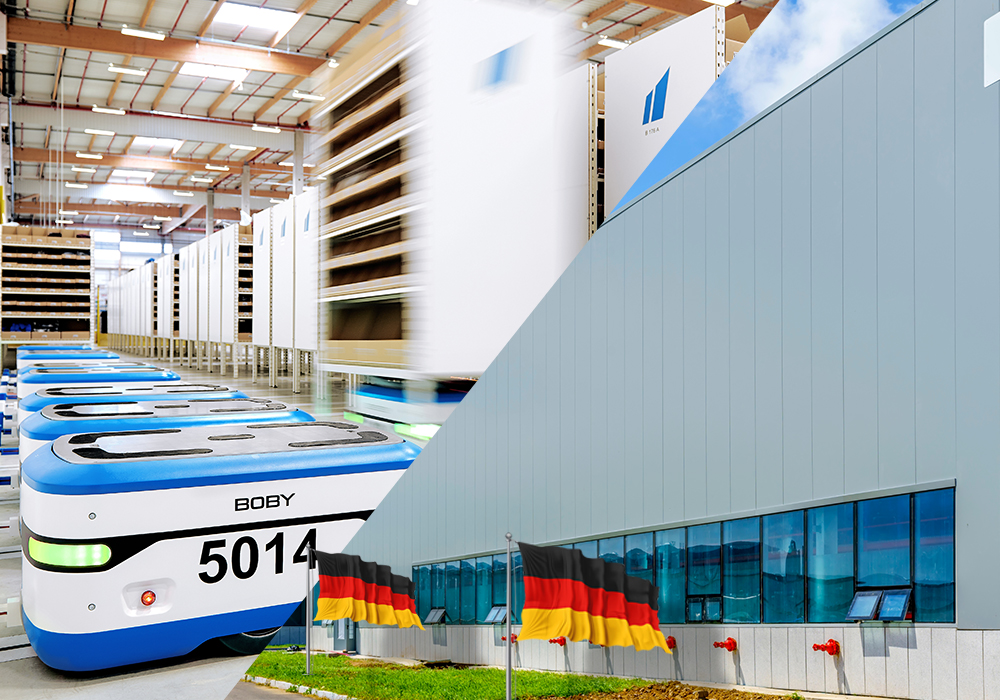The SCALLOG robotics solution, coupled with XPROMA’s expertise, at the heart of the space, productivity and energy optimization challenges for logistics players in Germany!

With the largest number of warehouses in Europe, Germany has made logistics one of the levers of its economic growth. At a time when there is a shortage of storage space, soaring energy costs among the highest in Europe and rising wages in the face of inflation, German logisticians must now gain in m² and productivity in picking, by favouring resolutely agile and less energy-consuming automation. To respond to the triple problem of space saving, productivity and energy sobriety, XPROMA presents, on the occasion of LOGIMAT, the Goods to Person solution from the French nugget SCALLOG – shelves transported by robots to operators – which allows you to double or even triple your productivity in order preparation, and to improve your storage density, and all this at reasonable costs!
Improve your storage density, in the face of the shortage of m²!
Faced with the shortage of available land and the explosion of construction costs – on average more than 25% according to Global GSE – German logisticians must now optimize the m² in their warehouses, favouring flexibility or even exploiting ceiling height and tracking down voids. A key trend in the optimization of logistics space in Europe, especially in France, already more than a quarter of SCALLOG’s 70 customers operate its Goods To Person robotic solution under or on the mezzanine, in both new and existing warehouses. Indeed, it is now necessary to provide green spaces, parking lots, etc. in a state-of-the-art logistics platform. synonymous with unused m². The same applies to the existing warehouse, where every m² must be profitable, without any land extension. The SCALLOG solution acts on two key factors in the performance of a warehouse, the yield per m² and the productivity of the people. It makes it possible to densify storage, while eliminating travel and limiting painful movements by operators. Thus, the SCALLOG solution, deployed by XPROMA, makes it possible to divide the picking area by 2 or even 3 and increase the productivity of operators by more than 40%, by easily integrating into all types of warehouses, from the oldest to the newest!
Gain agility in your “intralogistics” in a VUCA world!
In an increasingly VUCA (Volatibility, Uncertainty, Complexity and Ambiguity) world, logistics, and de facto the warehouse, requires a permanent ability to adapt in order to absorb hazards and meet changing consumer demands, including ever greater product availability and speed of delivery. One of the key factors in transforming hazards, fluctuations… In terms of “business” opportunities in the warehouse, it is a resolutely agile and adaptable intralogistics. Scalable and relocatable, the SCALLOG Goods to Person solution easily adapts to fluctuations in logistics activity, from peak management to relocation, while meeting the challenges of the sector. For example, the SCALLOG solution stands out in the industry with a denser storage of spare parts and/or components, a threefold increase in picking productivity and “flawless” quality control ! In addition to the deployment of the Goods to Person robotic solution, XPROMA, in close collaboration with SCALLOG, is resolutely positioning itself as a value-added integrator to maximize existing intralogistics such as conveyors… or even install a mezzanine. As an expert in intralogistics, XPROMA supports the German logistician at all stages, with its demonstrated robotic experience, its mastery of industrial equipment and its seasoned team. Thus, the SCALLOG robotics solution, coupled with XPROMA’s expertise, is at the service of the business needs of German logisticians, with a focus on adaptability, scalability and agility!
In addition, SCALLOG goods-to-person robotics can be ideally integrated into energy-efficient automation. In addition to its low-energy robots, the SCALLOG solution actively contributes to reducing the warehouse’s energy bill by eliminating the need for travel, from the intensive use of electric handling equipment to the automatically triggered lights in the aisles.






